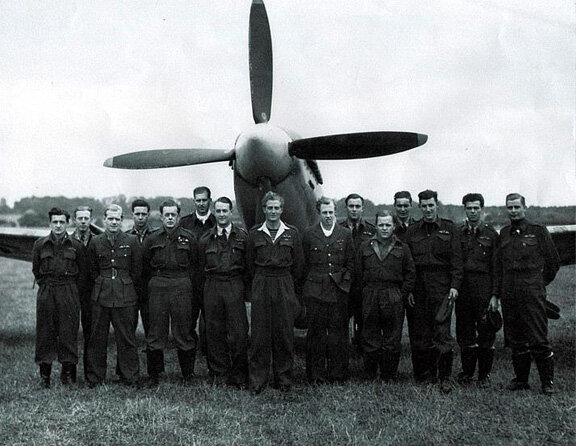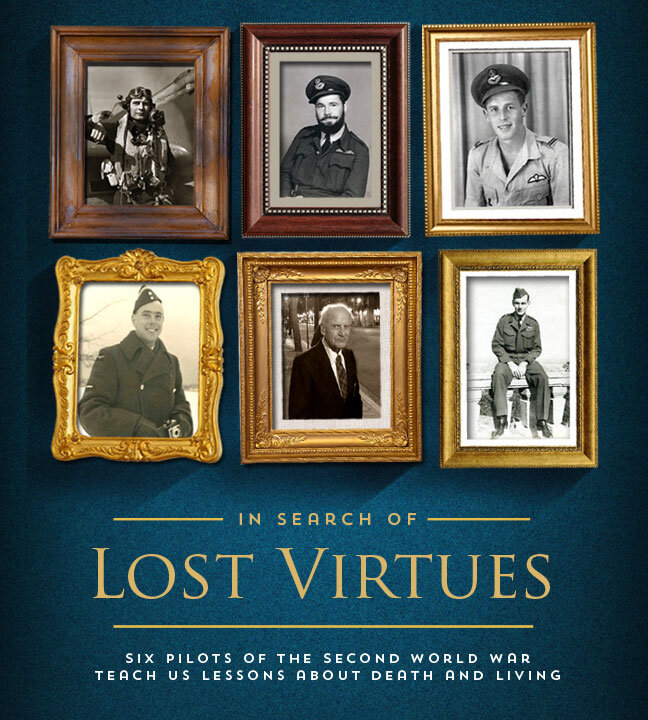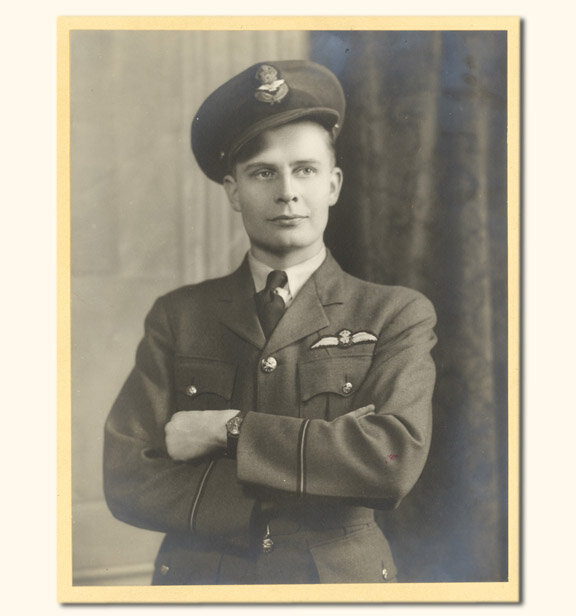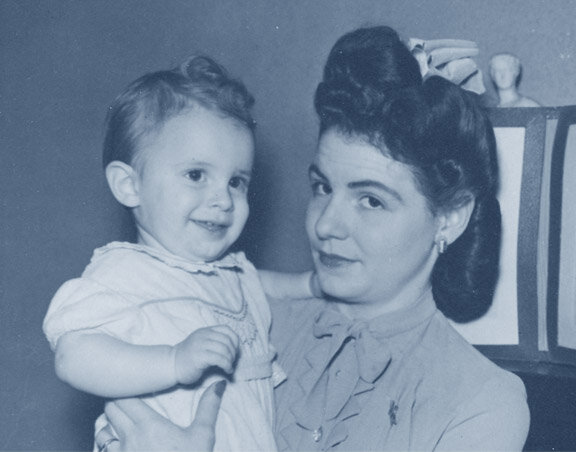THE HERO BEHIND THE RESURRECTION OF THE ROSELAND SPITFIRE
In 1999, members of the Comox Air Force Museum, on Vancouver Island, began a decade long project to construct a Supermarine Spitfire IX from the ashes of a former South African Air Force wreck. When finished, this Spitfire will fly in the markings of one that served in the Second World War with the famous and still existing 442 Squadron—based today at Comox. The Y2-K markings it will carry are a tribute to the home squadron and to the Millennium fund that got the project started. During its combat career, Y2-K was flown by many individual pilots of 442, but none came close to the 65 sorties on which it was flown by a man known to his friends simply as Rosey. This is his story.
On the afternoon of Thursday, 13 July 1944, Squadron Leader Harold James Dowding led his 442 Squadron pilots back home across the French countryside after an uneventful fighter sweep behind enemy lines. According to the Calgary Highlanders war diary for that day, the weather was fair and warm with a slight breeze reported at ground level. The loose formation of battle-worn Supermarine Spitfires rose and fell together in the warm air as they made haste for home. The pilots of 442 were always happy to be returning home alive. The heat of a summer’s afternoon beat down on the young men as they watched each other and the skies around them. They had been in continuous operations over enemy territory for more than five weeks since the massive D-Day landings. Dowding himself had been the first Allied pilot to make a two-wheels down landing in France on the 9th of June—an emergency landing. Returning to England by boat, he would soon lead his entire squadron back to Sainte-Croix-sur-Mer, France to a hastily prepared airfield inland from the beaches. It seemed like a lifetime ago for the men of 442 and all had no illusions about the months of killing and sacrifice ahead.
The Canadian boys had just climbed through a 1,000-foot-deep layer of cloud, breaking out into the heat of a summer sun at 4,000 feet on their way to 6,000. Despite the heat inside their cockpits, the steady beat of their Merlins and the closeness of their base on the Normandy coast, their eyes and hearts were alert and fearful. Though they had established a degree of dominance in the skies over eastern France over the past month, they suffered no delusions about air superiority.
Astern of Dowding, Flight Lieutenant Arnold Walter “Rosey” Roseland, 27, led the six Spitfires of Green Section, spread out behind Dowding like a wake. Rosey was a well-loved squadron pilot, more experienced than most, who had been with 442 Squadron when it was called 14 Squadron and flew P-40 Kittyhawks in an altogether different place against an altogether different enemy—the Japanese in the Aleutian Islands, below the Bering Sea. There, the cold and rain had been constant hardships and the hunting had been poor. Here, over France, the heat was oppressive, and the enemy was always near.
Roseland, like all the rest, was a highly experienced pilot with keen eyes, a bold heart and a strong desire to get the war over with and go home. As a Green Leader, he scanned the French sky above and the cloud below for enemy aircraft. Through a gap in the cloud, the sharp light of the sun glinting from a canopy far below caught Rosey’s attention. In an instant he focused on the light, making out a small swarm of German fighter aircraft below the cloud. Informing Dowding that he was going to take them on, Roseland rolled hard over and led his wingman Flying Officer Hugh McClarty (in Y2-T) and the rest of Green Section (Morse in Y2-W, Wright in Y2-V, Burns in Y2-U, and Campbell in Y2-X) down through the gap. Dowding kept his group above the cloudbank in the hopes of getting any Germans that rose up out of its cloak. They orbited above the battle, prowling and watching through broken cloud.
Pilots of newly formed 442 Squadron in 1944. Arnold Rosey Roseland is at the extreme right. Standing in the middle (with the visible striped T-Shirt) is S/L Blair Dalzell “Dal” Russel. The exact time and location of this photograph is not established, but Russel was commanding this squadron between 1 May to 15 July 1944, which gives a hint about the time frame. Photo: RCAF
Below them, 12 grey camouflaged Focke Wulf 190s and Messerschmitt Bf 109s broke their formation the second they spotted Roseland screaming down from above, and made for the cover of cloud. Roseland attached himself and his wingman McClarty to the tail of one Bf 109 following it in and out of cloud trying to get off a shot. In the course of trying to stay on the tail of the German fighter, Roseland lost his wingman McClarty who remained in the fight. Roseland then lost the German in the cloud and radioed his section to rejoin him above the cloud at 7,000 feet.
However, without a wingman to watch over him, and now alone below the cloud, the German fighters turned on him like a pack of wolves. Roseland’s life was down to just a few minutes.
Below, in the fields and farms near Saint-Martin-de-Mailloc in Normandy, French farmers had watched the 12 German fighters making their way across their land. Four years of occupation by the haughty conquerors had not made them welcome, and the French watched their passage with detached hatred. The Teutonic snarl of their BMW and Daimler Benz engines had become commonplace in the skies above their farms in the past few years, but more so in the past month since the invasion. With eyes shielded against the bright haze below the cloud they followed the hated German machines from the eastern horizon as they made their way west, praying that they would continue and not bring death to their doorsteps. But there was another, more distant, sound that could just be made out over the sound of the Germans—far above through a gap in the cloud a few of the French farmers watched as a flight of Spitfires flicked over onto their backs and dove in pairs to attack the Germans. The Merlin engines of the beautiful Allied fighters howled their battle cry as their pilots pushed their throttles to the detents.
French farmers in the region of Normandy had learned the hard way that a vicious dogfight above their heads was a dangerous entertainment. They quickly warned their families and friends to get indoors. Soon the thump and rattle of cannon and machine gun mixed with the howling engines. Red tracer and dirty smoke slashed apart the sullen sky. Spitfires followed Messerschmitts who followed Spitfires. Across the wide French landscape, aircraft rolled and climbed and turned, engines pushed to the maximum, heavy cannon rounds and streams of spent machine gun bullets thudded into the fields of crops, criss-crossing in seeming random gashes, sending up small puffs of soil. From the sky, heavy brass shell casings rained down upon the fields - still smoking and hot to the touch. It was not good to be outdoors—especially when a fighter lost its battle.
As the unknown young men fought for their lives over their heads, the people of Saint-Martin-de-Mailloc, including a teenager named Pierre Behier, watched—some from the safety of houses, some still working in the fields. On the farm belonging to Behier’s future wife, the main house was crowded with 22 men, women and children seeking shelter from the firestorm in the sky. Outside, several men and boys including Behier watched in fear and awe as the battle raged. In particular, they watched as the last Spitfire was set upon by five snarling, black-crossed Messerschmitts.
Round the French landscape, the fight rolled and slashed like a deadly game of crack the whip. Like a moose in deep snow, surrounded by snapping wolves, it was only a matter of time before a deadly blow was struck. The Spitfire pilot was clearly fighting for his life. After several minutes, one German managed to cut the Spitfire with a row of cannon rounds setting it on fire. Now, in its last seconds, it descended in a long sliding fall, trailing smoke—towards Behier, the farmhouse and the 22 souls it harboured. The pilot, according to those that watched, slid the canopy back and seemed to be steering the dying Spitfire away from the farmhouse. At the last second, the pilot emerged from the cockpit and pulled the ripcord of his parachute while Behier watched in horror. The trailing chute caught in the Spitfire’s tail and the pilot followed his burning aircraft over the heads of the young French onlookers and straight into ground not ten metres from the farmhouse. The forward motion from the descent and crash catapulted the dying pilot over the wreckage in the manner of a trebuchet—a full 100 metres further, where his broken body collided with a thick fencepost snapping it in half.
The body, broken and lifeless, came to rest near a cider barn. Pierre Behier and a friend ran to the young pilot who lay warm but lifeless and still attached to his white silk parachute, his eyes staring towards a sky he would never again see. Smoke from the wreck fouled the air. Shocked family and friends streamed from the house, now that the dogfight was over. A small photograph of a beautiful woman was found in the soil of the field that lay between the house and the dead pilot—now surrounded by villagers from Saint-Martin-de-Mailloc. One person found a brass Zippo with the word “Roseland” inscribed upon it.
Within minutes German soldiers, in heavy steel helmets and weapons slung over shoulders rode up on mud-spattered motorcycles to search the body they had seen fall from the sky. They wrenched from it a wallet, ID papers and from the women who had retrieved it from the field, the photo of the beautiful woman. The young German men, who perhaps had witnessed the ferocity with which he had fought his last fight, saluted the body, mounted up and roared off down the dirt lane.
Related Stories
Click on image
It was surreal beyond words. In the long grass near the barn lay an unknown man, handsome, young, covered in dirt and blood. The sound of songbirds had returned after the black thunder of the Luftwaffe had receded over the horizon. The breeze wafted and billowed his torn and useless parachute. Smoke drifted. Children sobbed. A lock of Roseland’s sandy coloured hair fluttered in the same breeze. A shoulder patch with the word CANADA, a brass lighter with the strange inscription Roseland, and a stolen photo of a woman not yet aware of the tragedy played out in Saint-Martin-de-Mailloc. This comprised the only identity offered up by God for this young man. Whoever he was, he was a long, long way from home. It was not lost on the French people standing there, that this man had died trying to drive the Germans from their land. Little did they know it, but the airman on the ground beneath the sullen French sky on that July afternoon, surrounded by saddened French villagers would not get home for another 55 years. But get home he would—to the son he never knew.
Arnold Roseland was a Canadian, born in a sod hut, the son of Norwegian immigrants in the middle of the last Great War in the middle of the sweeping cattle country of the Canadian prairies. Today, his birthplace Youngstown, Alberta, boasts a population of 170 souls. It was from small rural towns such as Youngstown across Canada that men like Bert Houle (Massey, Ontario), Stocky Edwards (Nokomis, Saskatchewan), and Arnold Roseland came to place their lives on the roulette of war for, as the motto of 442 Squadron said: One God, One King, One Heart.
Pierre Behier would grow up to become Mayor of Saint-Martin-de-Mailloc and spend 50 years looking for first the identity, then the family of that young man whose death he witnessed in 1944. The town would eventually find Ron Roseland-Barnes, the son of Arnold Roseland, in Oakville, Ontario and invite him to attend the dedication of a memorial to that sweet, young man who died on their land so long ago. What ensued was full of friendship, tears of long-awaited grief, happiness and pride in a father Ron was just getting to know.
Ron and his two sons travelled to France and were met and hosted with great ceremony by Pierre Behier and the entire townsfolk of Saint-Martin-de-Mailloc. For the first time in his life, Ron learned the truth about his father and the impact his death had on an entire community. A town was overwhelmed with emotion at bringing closure for themselves and for Ron. Arnold’s body will forever rest in a Canadian War Dead Cemetery in France, but now, for the first time, he is truly home
A young Leading Aircraftman Arnold Roseland at the time of his training. Arnold enlisted in 1940 and like many before and after him started his RCAF career at No. 1 Manning Depot in Toronto. From here he was sent to No. 11 EFTS (Fleet Finches) at Cap de la Madeleine, Québec and then to Ottawa to do his service flying training (Harvards and Yales) at No. 2 SFTS Uplands. Photo: Roseland Family Archives
It becomes easy to see that Arnold’s flight training has turned him into a confident young man. He wears the wings of a Royal Canadian Air Force pilot, the single stripe of a recently commissioned Pilot Officer and the confident and somewhat bemused smile of a man who knows what he is about. After earning his wings, Arnold was ordered to Central Flying School at RCAF Trenton on Lake Ontario. Here he would become a generalist pilot, taking instruction on many different types—enabling him to take a multitude of aircraft types into the air (Anson, Battle, Bolingbroke, Fawn, Cornell, Crane, Finch, Harvard, Hudson, Hurricane, Oxford, Ventura, Lockheed 10)—a skill needed for station pilots at Navigation and Bombing and Gunnery schools. After Trenton he was posted to the Bombing and Gunnery School in MacDonald, Manitoba. Photo: Roseland Family Archives
A proud Arnold stands protectively over his beautiful bride Audrey. Photo: Roseland Family Archives
After he received his wings, Arnold Roseland did a stint as a station pilot at No. 3 Bombing and Gunnery School in MacDonald, Manitoba and then was transferred to 14 Squadron. This P-40 Kittyhawk-equipped fighter squadron was based back in Ottawa at RCAF Station Rockcliffe just on the other side of the river from Vintage Wings of Canada's present site in Gatineau. Here, Roseland (middle) flies with two others for their Christmas card photograph. In the background are the mountains of the British Columbia Coastal Range. This unit was formed at Rockcliffe, Ontario, on 2 January 1942. It was commanded by Squadron Leader B.D. Russell, DFC, until November 1942, when Squadron Leader B.R. Walker, DFC, took over. From March 1942 until February 1943 it was based at Sea Island (Vancouver) but, from 3 March to 15 September 1943, it was based at Umnak in the Aleutians. Detachments at Amchitka were established 17 April to 15 May and again from 9 July to 29 August. In the first of these the squadron took part in 14 missions (88 sorties) and in the second 16 missions (102 sorties), chiefly dive-bombing Japanese positions on Kiska. During this campaign eight members of the squadron were awarded the U.S. Air Medal and two were Mentioned in Dispatches. From 24 September to 23 December 1943, No. 14 was based at Boundary Bay, B.C. It was then sent overseas, renumbered No. 442; and became a Spitfire Squadron. Photo: Roseland Family Archives
The inscription on the back of this photo reads “Canadians just before Kiska Raid, Amchitka 1943”. Arnold Roseland is on the left at the front. Note the steel runway plating required to keep the aircraft out of the mud of an Aleutian runway. Photo: Roseland Family Archive
The pilots of 14 Squadron RCAF somewhere in the Aleutians in the summer of 1943. Roseland is second from right. Roseland and his squadron would return to Boundary Bay near Vancouver on 5 October, just missing the birth of his second son Ronald. Photo: Roseland Family Archive
Possibly taken at Sea Island in 1942, a more formal photo of the NCO and Officer pilots of 14 Squadron—Rosey stands fourth from the right. Photo: Roseland Family Archive
Arnold and Audrey. Judging by the two solid stripes of a Flight Lieutenant on Arnold’s epaulettes, this photo was taken perhaps in the winter before going overseas with 14 Squadron where they were reformed as 442 Squadron. Discussing this photo with Ron Roseland-Barnes we thought perhaps it was taken in or around Lachine, Québec or Montréal where Roseland and his wife Audrey enjoyed his 3 weeks leave before boarding a troopship for Europe. Photo: Roseland Family Archive
Fast Forward to the future
442 Squadron Spitfires wore the Squadron code Y2 on their sides. That day, anyone who chose to look at the burning wreck more closely would have seen that the Spitfire wore the code Y2-P for Peter. That was an aircraft that Roseland had flown several times, but it was not “Rosey’s” Spitfire. That honour had gone to Y2-K, one of the squadron birds in which he had flown an incredible 65 missions since the Squadron was renamed and stood up in January of 1944. The fate of the Y2-K Spitfire (and it is possible that there were several individual Spitfires with the K code) is not known, but sixty-five years later, volunteers of the Comox Air Force Museum came up with a bold and beautiful plan to celebrate both the coming millennium (Y2-K) and their resident Canadian Air Force squadron—442 Search and Rescue.
A month after Roseland’s death, the Squadron was still operating from temporary airfields in France. Here is Rosey’s Spit, Y2-K, having an engine changed in the field on 14 August 1944. Photo: RCAF
There is no doubt that Y2-K was Roseland’s preferred Spitfire—in this typical page from his logbook, we can see that he flew her 16 times in this two-and-half-week period alone. In all he would fly Y2-K on 65 sorties. Photo: Roseland Family Archive
This logbook page is the facing page of the previous one, outlining in detail the events of each operation. We can see that on 14th of June, he received a “New ‘K’ ”—possibly a replacement aircraft. Also, the two swastikas drawn in the margin on the 30th on his second of 3 ops that day indicate he shot down two enemy aircraft. The detail included in his logbook is far more extensive than most and shows a deep concern for others in his squadron. Photo: Roseland Family Archive
Receiving some seed funding from a Millennium fund, they were able to acquire the collected parts of a former South African Air Force Spitfire IX—literally a crate of corroded, twisted and for the most part unsalvageable former Spitfire parts, the most important being the Supermarine data plate which for all intents and purposes made this pile of parts a real Spitfire.
To describe the importance of the data plate we like to use the “My Grandfather’s Broom” metaphor. The data plate is like the name “Granddad’s broom”. Your grandfather gives the broom to your father and sometime during the years he owns it, he breaks and replaces the handle, then later you inherit the broom. After a few years you wear out the brush and replace this part. Now, while the broom has neither handle nor working end that was there when your Grandfather used it, you can still claim it as your “Granddad’s Broom”. Such is the importance of the data plate. Without it, the line of its heritage is broken and your restoration is not a Second World War fighter, but instead the much less regarded “replica” of a Second World War fighter.
The Comox team invested thousands of hours of their own time and resources to take the pile of twisted metal and bring it to life as a fully restored Spitfire fighter in the markings of Y2-K. The progress was slow, but of the highest quality possible—equal to any restoration extant—and all from volunteers with little experience. Some even took courses in the skills and technology needed to bring it to flying condition. They had an endless supply of skill, energy, time, enthusiasm, knowledge and commitment—but were in short supply of the funds needed to move forward. Nearly ten years after they began their dream the project was at full stop, with no foreseeable funds coming down the tube.
It was possible that their dream of a 442 Squadron Spitfire flying in Canadian skies would soon die and the substantial work (a nearly complete fuselage) packed and sold to the highest bidder—possibly to end up in England or the U.S. Vintage Wings of Canada has stepped forward with a plan that will guarantee their dream of a 442 Squadron Spitfire flying for Canadians to see—a living icon that will teach future generations about men like Arnold Roseland.
The Air Force, the Comox Museum and Vintage Wings have entered an agreement which states that Vintage Wings will acquire the project and the work to date for the symbolic sum of one dollar, with a guarantee that we will invest all the funds necessary to complete the project—an estimated $1.5 million dollars. In addition, Vintage Wings will manage the completion of the project in Comox, using the same cadre of volunteers (under a VW manager who will ensure the timely and forward progress). The wings and engine will be built under subcontract to professionals in England and the U.S., but the completion of the main fuselage and final assembly will continue at Comox. Following completion of the restoration, the aircraft will be flown in the Comox area for a flying season, and then displayed at several locations across Canada. It will then be based close to the pilots with Spitfire experience at the VWoC facility near Ottawa. Here it will join Y2-C (our 442 Squadron Mustang) as well as the Hampton Gray Corsair, the Willie McKnight Hurricane, the Stocky Edwards Kittyhawk, the William Harper Spitfire, the John Moffat/Terry Goddard Swordfish, the Jack Spence Lysander and the John Gillespie Magee High Flight Harvard.
A beautiful machine such as a Spitfire, imbued with the soul of a fighter, needs a powerful name, a name that evokes memory and great sacrifice. Now and forevermore, the Y2-K Spitfire will become for Vintage Wings of Canada the Roseland Spitfire, named for the brave Canadian who gave his life for One God, One King and One Heart. It will teach all Canadians his remarkable story. Roseland will be the man whose heart is the heart of this machine, whose soul lives inside its metal skin. Arnold Roseland and the men of 442 will be the story we will teach our children.
By Dave O’Malley
Ronald Roseland, Arnold’s second son, would never get to know his father, but the freedoms won by his selfless actions allowed him to grow up in a safe and strong environment. That was his gift to his son. Here the young Ron is dandled by the beautiful Audrey whose photograph was found at the site of Arnold’s crash.Photo: Roseland Family Archive



















